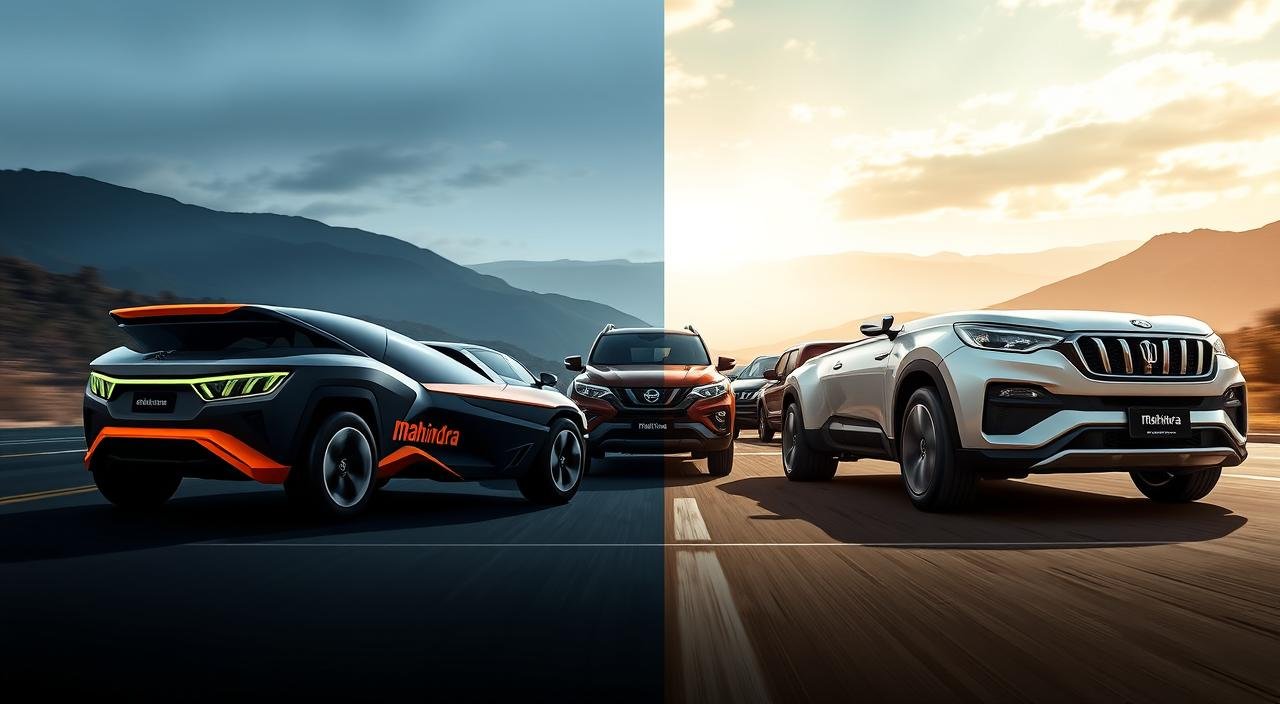
Aug
Mahindra, a giant in the Indian auto world, is at a turning point. Their current SUVs, like the XUV700, are big hits in India. But, their Vision concepts aim to take a huge leap forward.
The Vision.T concept shows Mahindra’s big plans with the Nu IQ platform. It supports both electric and traditional engines. This 5-door SUV keeps the classic look off-road fans love but adds the latest tech.
The XUV700 is a top choice now, with prices from Rs 14.50-25.14 lakh. It comes with 200 PS turbo-petrol and 185 PS diesel engines. It also has cool tech like all-wheel-drive and a panoramic sunroof.
Mahindra’s future models, like the Vision.T, are even more exciting. The interior has a modern dashboard, big screens, and digital displays. A cool steering button adds a touch of modernity. These features show Mahindra’s focus on both function and luxury.
Key Takeaways
- Mahindra Vision.T concept evolves from the Thar E design on the versatile Nu IQ platform
- Current XUV700 offers 200 PS petrol and 185 PS diesel engines with ADAS technology
- Vision concepts support both internal combustion and electric powertrains
- Traditional boxy SUV design meets modern tech in future Mahindra models
- Price range for current lineup spans Rs 14.50-25.14 lakh with premium features
- Interior innovations include vertical touchscreens and digital driver displays
Overview of Mahindra’s Vision Concepts
Mahindra has boldly stepped into the future with its electric vehicle concepts. The Vision.T concept was unveiled on Independence Day. It shows how off-road skills can blend with green tech.
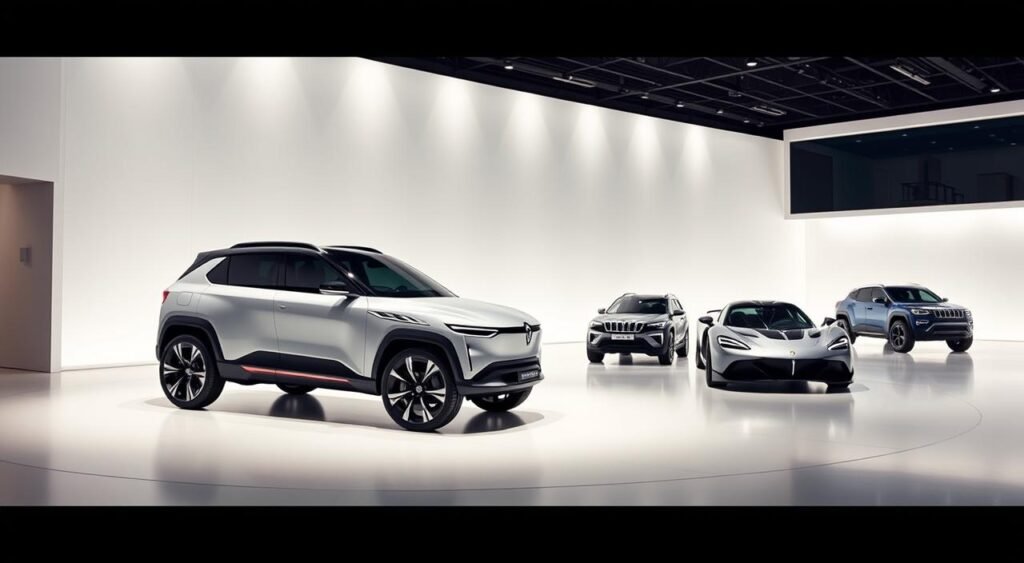
What Are Vision Concepts?
Vision concepts are design studies that hint at future cars. They test new tech and looks. The Vision.T turns the Thar into an electric vehicle, keeping its tough vibe.
Key Features of Mahindra’s Vision Concepts
The Vision.T has some cool design features:
- Six-slat split grille like the Thar Roxx
- Squared headlights with split vertical LED DRLs
- Chunky blacked-out bumper with an exposed yellow tow hook
- Boxy profile with an upright stance
- Rear door handles on the C-pillar
- Tailgate-mounted spare wheel with squared tail lights
Future Trends in SUV Design
This Mahindra SUV Review shows new trends in design. Electric cars are changing SUV looks, allowing for creative interiors. The Vision.T keeps its off-road spirit but uses green materials and smart lights.
Understanding Mahindra’s Current SUV Lineup
Mahindra is a big name in the Indian SUV market. They offer a wide range of vehicles. Each model has advanced tech and strong performance, meeting different customer needs.
From small urban SUVs to big family cars, Mahindra’s SUVs stand out. They have unique features that make them special in the car world.
Popular Models Available in India
The XUV700 is a top choice in Mahindra’s lineup. It has a cool 10.25-inch dual-screen setup for entertainment and car info. It also has connected car tech and climate control for comfort.
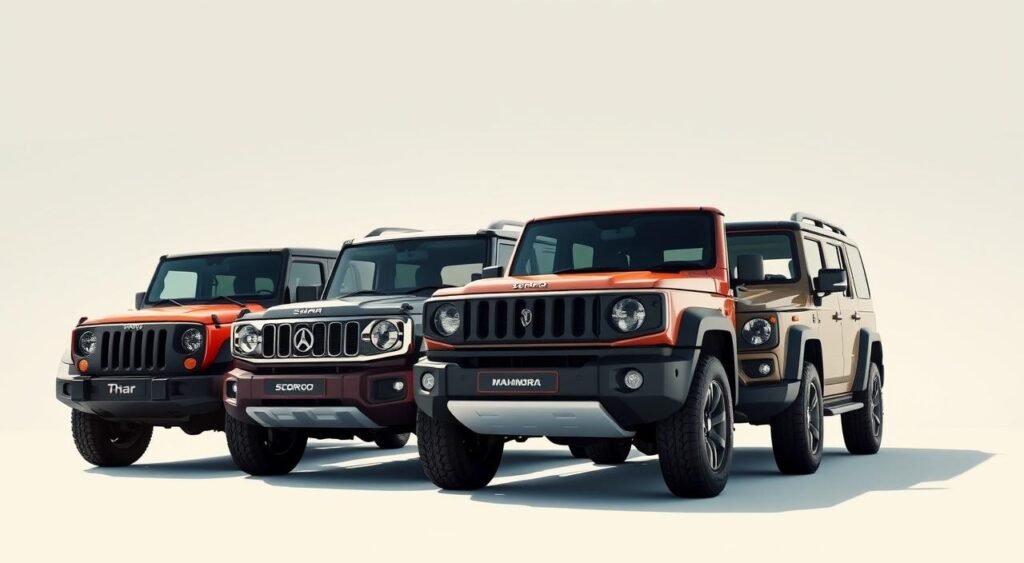
Other great models include the Scorpio-N, Thar, and XUV300. Each one is designed for different customers. Prices start at Rs 10 lakh and go up to Rs 27.44 lakh for the top models.
Performance Metrics of Existing SUVs
Mahindra SUVs are known for their power and fuel efficiency. The XUV700 has two engine options: a 200 PS turbo-petrol and a 185 PS diesel. You can choose between manual and automatic transmissions.
| Model | Engine Type | Power Output | Torque | Transmission Options |
|---|---|---|---|---|
| XUV700 | 2.0L Turbo-Petrol | 200 PS | 380 Nm | 6-Speed MT/AT |
| XUV700 | 2.2L Diesel | 185 PS | 450 Nm | 6-Speed MT/AT |
| Scorpio-N | 2.0L Turbo-Petrol | 203 PS | 380 Nm | 6-Speed MT/AT |
| Thar | 2.0L Turbo-Petrol | 150 PS | 320 Nm | 6-Speed MT/AT |
Safety is key with advanced driver assistance systems (ADAS) in premium models. Features like panoramic sunroofs and ventilated seats make driving better. These features help Mahindra compete with Tata Safari and Hyundai Creta.
Comparing Design Philosophies
Mahindra’s SUV design shows a unique mix of future visions and today’s cars. They blend old-school toughness with sleek looks. This makes their vehicles popular in India’s SUV market.
Aesthetic Differences in Vision Concepts
The Vision.T concept is Mahindra’s bold take on SUVs. It keeps the classic boxy shape but adds new tech. The flat front and big grille make it stand out.
It has square headlights and vertical LED DRLs for a modern look. The big wheels and off-road tires show its rugged side. Mahindra aims to mix function with style.
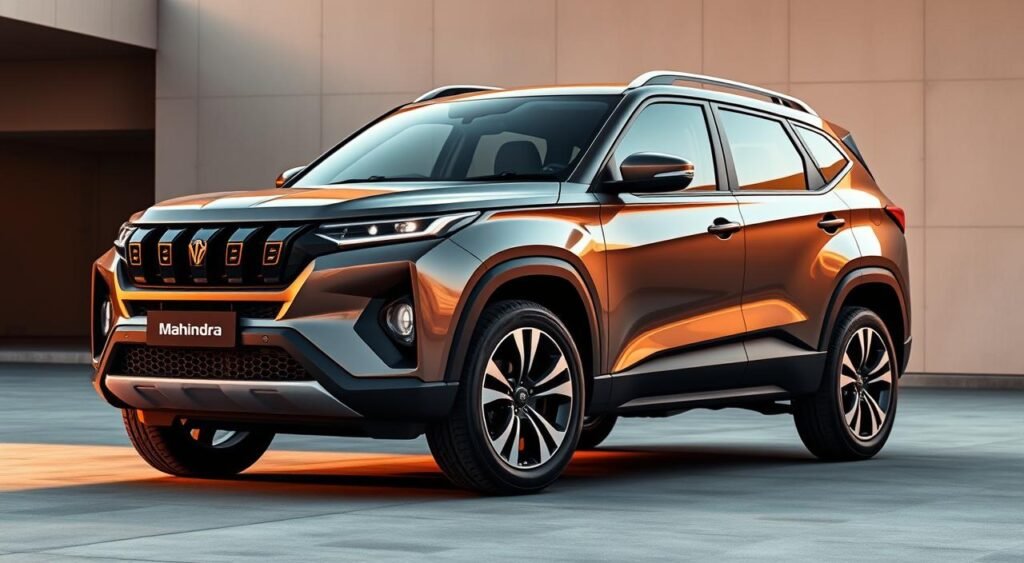
Design Trends in Current SUVs
Today, big sunroofs are a must-have in 7-seaters. Mahindra knows this and is updating their SUVs. The Hyundai Alcazar, for example, has a sunroof from the Prestige variant (Rs 15-21.74 lakh).
| Model | Sunroof Availability | Starting Price | Key Feature |
|---|---|---|---|
| Hyundai Alcazar | From Prestige variant | Rs 15 lakh | Voice command operation |
| MG Hector Plus | From Select Pro variant | Rs 17.50 lakh | 14-inch portrait display |
The MG Hector Plus also has a panoramic sunroof in its Select Pro variant (Rs 17.50-23.94 lakh). It comes with a big 14-inch display. These features show how today’s SUVs offer both luxury and practicality, inspiring Mahindra’s future designs.
Technology Innovations in Vision Concepts
The leap from Mahindra Vision Concepts to the current SUV lineup is huge. Mahindra’s future models bring new tech that changes how we drive. They mix digital smarts with real-world use.
Advanced Driver Assistance Systems
The Vision.T concept has a new cockpit design for the driver. A big vertical touchscreen is the main feature on the dashboard. It also controls the climate. The driver’s display is right in front, showing important info.
Some cool tech features include:
- A sports car-style starter button on the wheel
- Toggle switches for key car functions
- Voice commands for opening the sunroof
- Smartphone integration for connected cars
- Ambient lighting for a better cabin feel
Sustainability Features in New Models
The Nu IQ platform shows Mahindra’s focus on green cars. It works with both gas engines and electric power. This lets buyers pick what’s best for the planet.
Current SUVs have cool features like powered tailgates and safety tech. But the Vision concepts go even further. They offer more space and efficiency. This makes Mahindra’s Vision Concepts a big step towards better, eco-friendly cars.
Performance Specifications: Vision vs. Current
The Mahindra SUV Comparison between vision concepts and current models shows big differences. Current SUVs have proven powertrains and reliability. But, the new Mahindra Concept Vehicles will bring big changes with the Nu IQ platform.
This new platform will support both traditional engines and electric ones. It marks a big shift in Mahindra’s performance strategy.
Engine Options and Powertrains
Current Mahindra SUVs have many engine choices for Indian roads. The XUV700 has a strong 200 PS 2-liter turbo-petrol engine and a 185 PS 2.2-liter diesel. Both have all-wheel-drive for better traction.
| Model | Engine Type | Power Output | Torque | Transmission |
|---|---|---|---|---|
| XUV700 | 2.0L Turbo-Petrol | 200 PS | 380 Nm | 6MT/6AT |
| XUV700 | 2.2L Diesel | 185 PS | 450 Nm | 6MT/6AT |
| Scorpio-N | 2.0L Turbo-Petrol | 203 PS | 380 Nm | 6MT/6AT |
| Scorpio-N | 2.2L Diesel | 175 PS | 400 Nm | 6MT/6AT |
| Thar | 2.0L Turbo-Petrol | 150 PS | 320 Nm | 6MT/6AT |
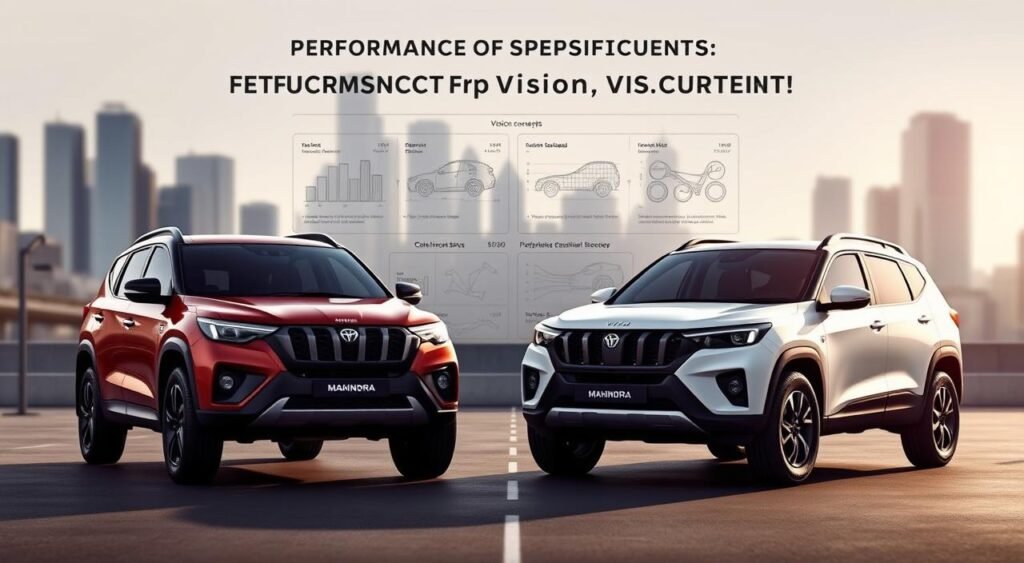
Handling and Driving Experience
The Mahindra SUV Comparison shows current models excel in different driving scenarios. The XUV700 has sporty handling with its suspension setup. The Scorpio-N is rugged.
Future Mahindra Concept Vehicles will have advanced chassis technologies for better ride quality. Electric variants will have instant torque, changing acceleration. The Nu IQ platform will improve weight distribution and lower center of gravity, better in electric models.
Consumer Preferences and Market Trends
The Indian car market is changing fast. Now, features found in luxury cars are expected in more affordable ones. Panoramic sunroofs are a big hit, showing how people want their cars to feel more luxurious.
Insights into Buyer Behavior
When looking for a new car, Indians focus on space, features, and value. Families want cars that are both practical and fancy. The desire for panoramic sunroofs shows they want to enjoy their drive without spending too much.

Car makers are now adding panoramic sunroofs to more cars. The Kia Carens, for example, offers this feature in its HTX+ variants. These cars are priced between Rs 11.50-21.50 lakh, showing how companies can offer luxury at a good price.
Demand for Electric and Hybrid Models
More and more Indians are interested in electric cars. Mahindra is leading the way with its Vision concepts. The data shows that many are now considering electric cars when they shop.
| Buyer Priority | Traditional SUVs | Electric/Hybrid Interest |
|---|---|---|
| Fuel Economy | 75% | 92% |
| Environmental Impact | 45% | 88% |
| Technology Features | 68% | 85% |
Pricing Strategies: Vision Concepts vs. Current Lineup
Mahindra carefully sets prices for its SUVs. They aim to be competitive and offer great value. The brand wants to match rivals’ prices but also add special features that make the cost worth it.
Cost Comparison with Existing Models
The Mahindra XUV700 is priced between Rs 14.50-25.14 lakh (ex-showroom). This makes it a strong contender in the premium SUV market. It goes head-to-head with other top players in India.
| SUV Model | Price Range (Rs Lakh) | Key Segment |
|---|---|---|
| Mahindra XUV700 | 14.50 – 25.14 | Premium SUV |
| Kia Carens | 11.50 – 21.50 | 3-Row MPV |
| Hyundai Alcazar | 15.00 – 21.74 | Premium SUV |
| Tata Safari | 15.50 – 27.44 | Premium SUV |
| MG Hector Plus | 17.50 – 23.94 | 3-Row SUV |
Premium features like panoramic sunroofs affect prices. For example, the Kia Carens HTX+ turbo-petrol variant costs Rs 21.50 lakh. This shows how advanced tech can raise prices.
Expected Pricing for Future Concepts
The Vision.T concept will likely enter the lifestyle SUV market. It will compete with the Mahindra Thar and others. Electric versions of future models will likely cost more due to battery tech and electric powertrains.
Future Outlook for Mahindra SUVs
Mahindra’s future in the SUV market is looking bright. The Vision.T concept is leading the way. It shows the company’s commitment to combining traditional toughness with modern technology.
The latest updates reveal plans to change how Indian consumers see electric vehicles. Mahindra aims to keep its reputation for building reliable, rugged vehicles.
Anticipated Features in Upcoming Models
The Nu IQ platform is at the core of Mahindra’s SUV development. It supports both electric and traditional powertrains. This makes the transition to electric vehicles smoother for buyers.
Future Mahindra models will have advanced connectivity features. These features will rival smartphones, allowing drivers to control various functions through mobile apps and voice commands.
Safety is a top priority with enhanced Advanced Driver Assistance Systems (ADAS). These include automatic emergency braking, lane-keeping assist, and adaptive cruise control. Mahindra will also use sustainable materials in vehicle interiors.
This includes recycled plastics and eco-friendly fabrics. These changes show Mahindra’s commitment to environmental responsibility. They do so without sacrificing comfort or style.
Potential Impact on the Indian Market
The Vision.T makes Mahindra a serious player in India’s electric SUV segment. This move could shake up the market, dominated by internal combustion engines. It offers practical alternatives to established models from Tata Motors and MG Motor India.
As charging infrastructure improves, these new Mahindra SUV updates could attract tech-savvy buyers. They are looking for greener transportation options. The competitive pricing strategy combined with advanced features might force other manufacturers to speed up their electric vehicle programs.
This would benefit Indian consumers with more choices and better technology.
FAQ
What is the Mahindra Vision.T concept and how does it compare to current Mahindra SUVs?
The Mahindra Vision.T is an updated version of the Mahindra Thar E concept. It’s built on the Nu IQ platform. It has a 5-door layout and a boxy SUV look.
Unlike current models like the XUV700, the Vision.T is an all-electric SUV. It offers both ICE and EV powertrains. This makes it a great alternative to the Mahindra Thar, Thar Roxx, and Force Gurkha.
What are the key features of Mahindra concept vehicles compared to existing models?
Mahindra concept vehicles like the Vision.T have advanced features. These include a large vertical touchscreen and a digital driver’s display. They also have a sports car-inspired starter button on the steering wheel.
Current models like the XUV700 have a 10.25-inch dual-screen setup. They also offer connected car technology and ADAS features. The Vision.T’s platform supports both ICE and EV powertrains, showing Mahindra’s move towards electric mobility.
How does Mahindra SUV technology in Vision concepts differ from current lineup?
The Vision.T concept has advanced connectivity and ADAS systems. While the XUV700 has ADAS technology and all-wheel-drive options, the Vision.T supports both ICE and EV versions.
This shows Mahindra’s commitment to electric mobility and sustainable materials. The Vision.T platform is designed for both ICE and EV powertrains.
What are the design differences between Mahindra future models and current SUVs?
The Vision.T has a traditional boxy SUV look but with modern touches. It has a six-slat split grille and squared headlights. The bumper is chunky and blacked out.
Current models have a more contemporary design. The XUV700, for example, has a panoramic sunroof from the AX5 trim. It follows modern SUV design trends.
What is the expected pricing for Mahindra SUV updates and future concepts?
The Vision.T’s pricing is yet to be announced. It’s expected to be competitive with the Mahindra Thar and Force Gurkha. The XUV700 is priced Rs 14.50-25.14 lakh ex-showroom.
In the competitive segment, rivals include the Hyundai Alcazar and Tata Safari. The MG Hector Plus is also a competitor. Electric versions of future concepts will likely have a premium price.
Which are the top Mahindra SUVs currently available and how do they compare?
The Mahindra XUV700 is the top model in the lineup. It has 200 PS turbo-petrol and 185 PS diesel engines. It also has ADAS technology and a panoramic sunroof from the AX5 trim.
It’s priced Rs 14.50-25.14 lakh. It competes directly with the Tata Safari and offers superior power output and advanced features.
What powertrain options will Mahindra SUV future models offer?
The Vision.T’s Nu IQ platform supports multiple powertrain options. This includes both ICE and EV versions, though specific details are unannounced. Current Mahindra models offer diverse engine choices.
The XUV700 has a 200 PS 2-litre turbo-petrol and a 185 PS 2.2-litre diesel. Both are available with manual and automatic transmissions. All-wheel-drive is available on select variants.
How is the Mahindra SUV review comparing Vision concepts to current models?
The Vision.T concept shows Mahindra’s evolution in SUV design. It combines traditional ruggedness with modern technology. It has an upright dashboard and a dual-tone interior theme.
Compared to current models like the XUV700, the Vision.T has a vertical touchscreen and a unique steering-mounted starter button. This makes Mahindra a leader in the electric SUV space.
![Mahindra Bolero Neo vs Mahindra XUV300 [2019-2024]](https://buyautomobile.in/wp-content/uploads/2024/12/Mahindra-Bolero-Neo-vs-Mahindra-XUV300-2019-2024.jpg)
Dec
Did you know the average price for a used 2022 Mahindra XUV300 W8(O) 1.5 Diesel Dual Tone [2020] in Kolkata is Rs. 10.96 Lakh? This shows how much Indian buyers invest in SUVs. The Bolero Neo and XUV300 are two top models from Mahindra. We’ll compare them to help you choose the right one.
The Mahindra XUV300 has impressive specs. The W8(O) 1.5 Diesel variant has 115 bhp @ 3750 rpm and 300 Nm @ 1500 rpm torque. It comes with a 1497 cc engine and a 6-speed manual transmission for a smooth ride. The Bolero Neo, on the other hand, is known for its rugged design, perfect for those who love adventure.
Safety is a big deal for both models. They come with airbags, rear middle three-point seatbelts, and Tyre Pressure Monitoring System (TPMS). The XUV300 also has Anti-Lock Braking System (ABS), Electronic Stability Program (ESP), and Hill Hold Control for better safety and control.
Key Takeaways
- The Mahindra XUV300 and Bolero Neo offer distinct driving experiences, catering to different consumer preferences.
- The XUV300 excels in performance, with powerful engine options and advanced safety features.
- The Bolero Neo appeals to those seeking a rugged, adventure-ready SUV.
- Both models prioritize safety, with features like airbags and tire pressure monitoring.
- Pricing and resale value are important considerations when comparing these Mahindra SUVs.
Introduction to Mahindra Bolero Neo and XUV300
Mahindra & Mahindra Ltd. is a big name in the Indian car market. They make many types of vehicles for different needs. The Bolero Neo and XUV300 are two popular SUVs that stand out.
Brief Overview of Mahindra
Mahindra & Mahindra Ltd. started in 1945. They are known for making tough and reliable cars. They focus on making cars that are good to drive, comfortable, and affordable.
Importance of Comparing These Models
When looking at Mahindra SUVs, people often compare the Bolero Neo and XUV300. Both offer the Mahindra quality, but they meet different needs and budgets. Knowing the differences helps customers choose the best car for them.
| Specification | Mahindra XUV300 | Mahindra Bolero Neo |
|---|---|---|
| Engine | 1.5L Turbocharged Diesel | 1.5L mHawk100 Diesel |
| Max Power | 115 bhp @ 3750 rpm | 100 bhp @ 3750 rpm |
| Max Torque | 300 Nm @ 1500 rpm | 260 Nm @ 1750-2250 rpm |
| Transmission | Manual – 6 Gears | Manual – 5 Gears |
| Fuel Efficiency (ARAI) | 20 kmpl | 17.29 kmpl |
The table shows some key differences between the Mahindra XUV300 and Bolero Neo. The XUV300 has a stronger engine and better fuel use. But the Bolero Neo is great for those who want a tough and affordable SUV. We’ll look closer at each model’s features and what they offer.
Design and Aesthetics
The Mahindra Bolero Neo and XUV300 have unique exterior designs. The Bolero Neo looks rugged and strong, with a boxy shape and tall stance. It has body cladding and a frontal guard, showing its tough nature and off-road skills. With 188 mm ground clearance, it’s ready for rough terrains and water crossings.
The XUV300, on the other hand, has a modern and stylish exterior design. It has sleek headlamps, a chrome-studded grille, and a sporty bumper. This gives it a premium and contemporary look. It has 180 mm ground clearance, balancing comfort and handling on uneven roads.
Interior Design Comparisons
The Bolero Neo’s interior styling is simple and practical. It offers comfortable seating for up to 7 people, with plenty of legroom and headroom. It has power windows, electric ORVMs, and a 7-inch touchscreen, making driving easy and fun.
The XUV300, in contrast, has a more premium and feature-rich cabin. It comes in four trims: W4, W6, W8, and W8 (O), for various budgets and tastes. Its interior is modern, focusing on comfort and technology. It has a 257-liter boot space, perfect for daily use and weekend trips.
| Feature | Mahindra Bolero Neo | Mahindra XUV300 |
|---|---|---|
| Seating Capacity | 7 | 5 |
| Touchscreen Infotainment | 7-inch | Available |
| Climate Control | Automatic | Available |
| Power Windows | Available | Available |
Performance and Engine Specifications
The Mahindra Bolero Neo and XUV300 have different engines for various drivers. We’ll look at each model’s engine, acceleration, and power.
Bolero Neo Engine Details
The Mahindra Bolero Neo has a strong 1.5-liter diesel engine. It makes 100 bhp and 260 Nm of torque. This engine is great for city driving and occasional highway trips, making the ride smooth and efficient.
The Bolero Neo’s engine balances performance and fuel economy. This makes it a good choice for those watching their costs.
XUV300 Engine Options
The Mahindra XUV300 offers both petrol and diesel engines. This caters to a wide range of drivers. The petrol engine is a 1.2-liter turbo that makes 110 bhp and 200 Nm of torque. It offers a lively and responsive drive.
The diesel engine is a 1.5-liter that produces 115 bhp and 300 Nm of torque. It has great pulling power and quick acceleration.
Acceleration and Power Output Comparison
The Mahindra XUV300 has a slight edge in acceleration and performance. Its engines have higher horsepower and torque, leading to quicker starts and a more engaging drive. But, the Bolero Neo’s engine is also powerful and suitable for most driving needs.
| Model | Engine | Horsepower | Torque |
|---|---|---|---|
| Mahindra Bolero Neo | 1.5L Diesel | 100 bhp | 260 Nm |
| Mahindra XUV300 (Petrol) | 1.2L Turbo Petrol | 110 bhp | 200 Nm |
| Mahindra XUV300 (Diesel) | 1.5L Diesel | 115 bhp | 300 Nm |
Choosing between the Bolero Neo and XUV300 depends on your needs and preferences. The Bolero Neo is good for those who want balance between performance and fuel efficiency. The XUV300 is better for those who want a more spirited drive and the option to choose between petrol and diesel.
Fuel Efficiency and Economy
Fuel efficiency and running costs are key when picking a vehicle. The Mahindra Bolero Neo and XUV300 stand out for their mileage and fuel use. They’re great for those watching their budget.
Bolero Neo Fuel Efficiency
The Mahindra Bolero Neo gets 17.29 kmpl, ARAI certified. This shows it’s good at using fuel, saving you money on trips. Its engine tech means you get the most from every liter.
XUV300 Fuel Economy
The Mahindra XUV300 has two engines, each with its own fuel-saving benefits. The petrol version gets 17 kmpl, while the diesel version gets 20 kmpl. These numbers show the XUV300’s focus on efficiency, letting you go further without needing to refuel.
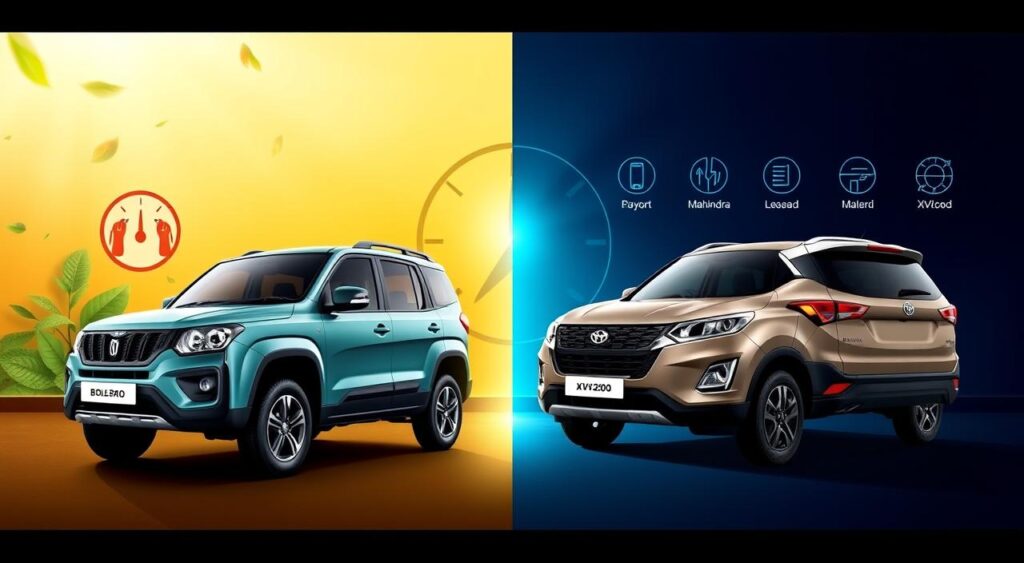
Cost of Ownership Considerations
Even though the XUV300 might be a bit better at fuel economy, think about the total cost of owning a car. The Bolero Neo is cheaper and has lower maintenance costs. This makes it a more affordable option over time. Here’s a look at the costs for each car:
| Model | Fuel Type | Mileage (ARAI) | Fuel Tank Capacity | Approx. Range |
|---|---|---|---|---|
| Bolero Neo | Diesel | 17.29 kmpl | 60 litres | 1,037 km |
| XUV300 Petrol | Petrol | 17 kmpl | 42 litres | 714 km |
| XUV300 Diesel | Diesel | 20 kmpl | 42 litres | 840 km |
The Bolero Neo’s bigger tank and good mileage mean you go further on one tank. This cuts down on gas trips and costs. Plus, its lower price and maintenance costs make it a smart choice for saving money in the long run.
Safety Features
Both the Mahindra Bolero Neo and XUV300 focus on keeping passengers safe. But, the XUV300 shines with its top-notch safety tech and better crash test ratings.
Safety Ratings for XUV300
The Mahindra XUV300 got a 5-star safety rating from Global NCAP. It shows the SUV’s dedication to keeping passengers safe. It comes with many safety features, like:
- 7 airbags for all-around protection
- Anti-lock Braking System (ABS) with Electronic Brake-force Distribution (EBD)
- Electronic Stability Control (ESC) for better handling
- Hill-hold assist for easy starts on inclines
- Tire Pressure Monitoring System (TPMS) to keep tires at the right pressure
Safety Ratings for Bolero Neo
The Mahindra Bolero Neo hasn’t been tested by Global NCAP. But, it has important safety features as standard, like:
- Dual front airbags for driver and passenger safety
- Anti-lock Braking System (ABS) to stop wheels from locking up during sudden stops
- Rear parking sensors for safer reverse moves
Comparison of Safety Technologies
The Mahindra XUV300 clearly leads in safety tech compared to the Bolero Neo. Here’s a table showing the main differences in their safety features:
| Safety Feature | Mahindra XUV300 | Mahindra Bolero Neo |
|---|---|---|
| Global NCAP Crash Test Rating | 5-star | Not tested |
| Number of Airbags | 7 | 2 (dual front) |
| Electronic Stability Control (ESC) | Available | Not available |
| Hill-hold Assist | Available | Not available |
| Tire Pressure Monitoring System (TPMS) | Available | Not available |
The Mahindra XUV300 is a top pick for those who value safety. Its advanced features, like Electronic Stability Control and more airbags, offer extra protection and peace of mind.
Technology and Infotainment
The Mahindra XUV300 and Bolero Neo have different tech features. The XUV300 has modern tech, while the Bolero Neo focuses on simplicity.
Tech Features in Bolero Neo
The Mahindra Bolero Neo has a simple tech setup. It has a basic 2-DIN audio system with Bluetooth connectivity. This lets users stream music and make calls without their hands.
The audio system sounds good enough for its purpose. It’s perfect for the car’s intended use.
Tech Features in XUV300
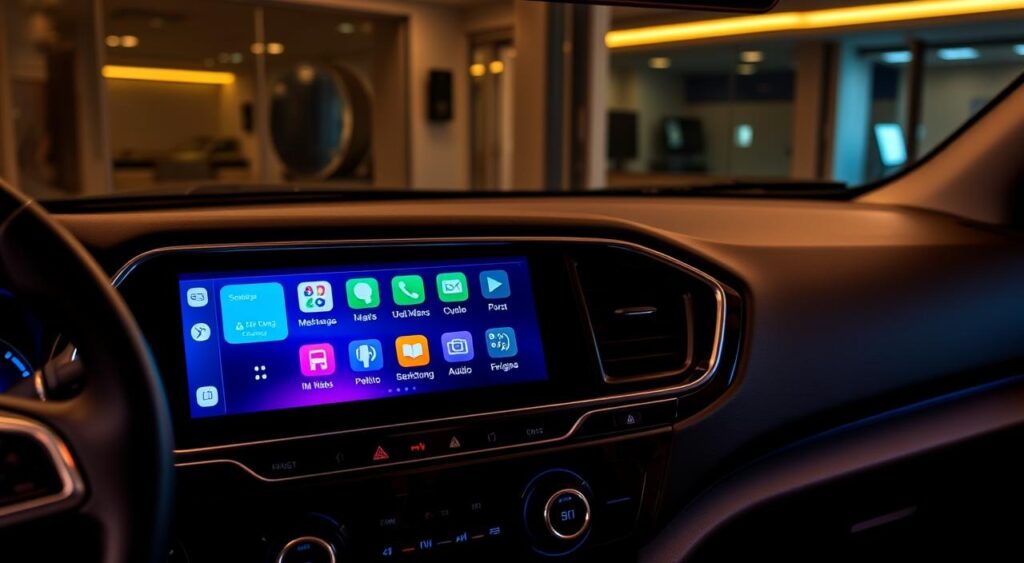
The Mahindra XUV300 has advanced tech. It has a 7-inch touchscreen infotainment system. This supports Android Auto and Apple CarPlay.
This setup makes smartphone connectivity easy. Users can use their favorite apps and listen to music on the screen.
The XUV300 also has a sunroof, cruise control, and push-button start. These features make driving more enjoyable and convenient. They’re great for those who love tech and want a premium car.
User Experience and Connectivity
The XUV300 offers a better user experience and connectivity. Its touchscreen infotainment system is easy to use. It lets users connect their phones and stay entertained.
The Bolero Neo’s audio system is simpler. It’s good for those who like things straightforward. It has Bluetooth for hands-free calls and music.
Comfort and Convenience
Both the Mahindra Bolero Neo and the Mahindra XUV300 focus on comfort and convenience. They offer features that make driving a pleasure. Let’s explore how they compare in seating, space, and comfort features.
Seating and Space in Bolero Neo
The Mahindra Bolero Neo has a roomy cabin. It has plenty of headroom and shoulder room, perfect for big families. It can seat up to seven people, with a layout of 2+3+2.
The seats are soft and supportive. They make long trips comfortable.
Seating and Space in XUV300
The Mahindra XUV300, though compact, has a cozy interior. It’s designed for five adults, with enough legroom and headroom. The seats are designed for comfort, making every ride enjoyable.
Key Comfort Features Comparison
Both SUVs have comfort features to make driving better. Here’s a look at some key features:
| Feature | Mahindra Bolero Neo | Mahindra XUV300 |
|---|---|---|
| Air Conditioning | Manual | Manual |
| Power Windows | Front and Rear | Front and Rear |
| Adjustable Seats | Driver and Front Passenger | Driver and Front Passenger |
| Cruise Control | Not Available | Available |
| Parking Sensors | Rear | Rear |
The XUV300 also has extra features. It has keyless start, a rear armrest with cup holders, and a cooled glove box. These add to the XUV300’s comfort and convenience.
Driving Experience and Handling
The Mahindra Bolero Neo and XUV300 have different driving experiences. The Bolero Neo is great for rough roads and off-road trails. It focuses on comfort over sporty handling. The XUV300 balances ride quality and handling well, perfect for city and highway driving.
Driving Dynamics of Bolero Neo
The Bolero Neo’s suspension absorbs bumps well, making rides comfortable. Its 180 mm ground clearance helps it tackle rough terrain. But, it rolls more in corners and has vague steering feedback compared to the XUV300.
Driving Dynamics of XUV300
The XUV300 offers a more engaging drive. Its suspension balances ride quality and handling well. The steering feedback is precise, making it easy to control in tight spaces or winding roads. Its shorter wheelbase and lower ground clearance make it more agile.
| Specification | Mahindra XUV300 |
|---|---|
| Engine | 1197 cc, 3 Cylinders Inline, 4 Valves/Cylinder, DOHC |
| Power | 109 bhp @ 5000 rpm |
| Torque | 200 Nm @ 1500-3500 rpm |
| Transmission | Manual – 6 Gears |
| Acceleration (0-100 kmph) | 12.88 seconds |
Off-Road Capabilities
Both vehicles are not made for serious off-roading. But, the Bolero Neo’s rugged build and high ground clearance are better for mild off-road trails. Its suspension setup makes it comfortable on rough terrain. The XUV300 is better for paved roads due to its lower ground clearance and road-oriented suspension.
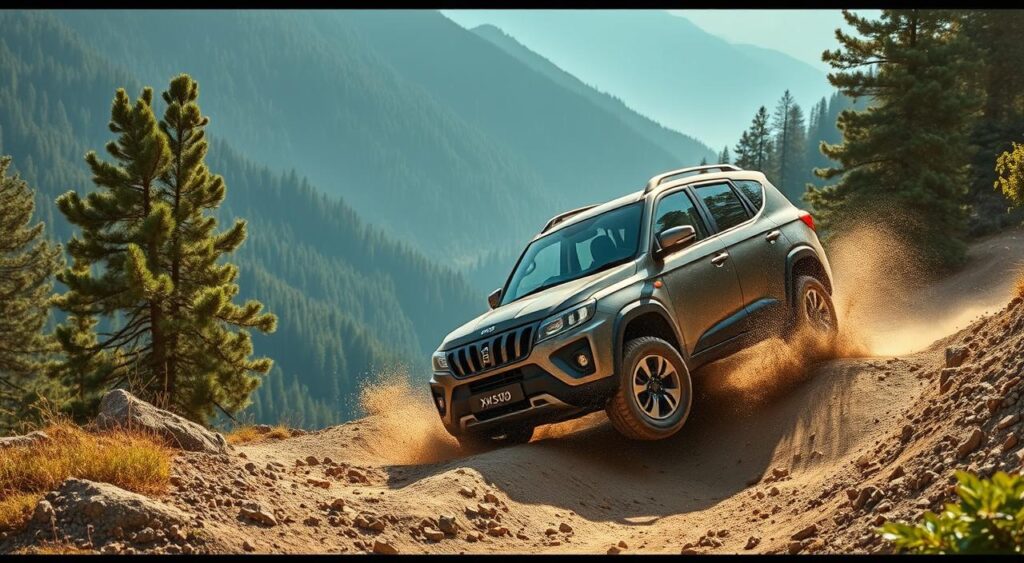
Pricing and Variants
The Mahindra Bolero Neo and XUV300 have different prices. The Bolero Neo is cheaper, while the XUV300 costs more. Let’s look at their prices and trim levels.
Pricing Structure for Bolero Neo
The Mahindra Bolero Neo starts at Rs. 9 lakh (ex-showroom). It’s a good choice for those on a budget. The top model costs about Rs. 11.5 lakh. This lets buyers pick the right model for their budget.
Pricing Structure for XUV300
The Mahindra XUV300 starts at Rs. 8 lakh for the base petrol. The top diesel model costs Rs. 14 lakh (ex-showroom). It offers more premium features, making it worth the extra cost.
Variant Comparison
The Bolero Neo seems to offer more value for money. It’s priced well and has lots of features. The XUV300 is pricier but offers style, comfort, and advanced tech.
Choosing between the Bolero Neo and XUV300 depends on your budget and needs. The Bolero Neo is great for those wanting a budget-friendly SUV. The XUV300 is for those who want a premium experience. Think about your driving needs, desired features, and on-road price to decide.
Ownership and Maintenance Costs
Thinking about buying a Mahindra Bolero Neo or XUV300? It’s key to think about the costs over time. These costs can really affect your budget.

Maintenance of Bolero Neo
The Mahindra Bolero Neo is simpler and has a wide service network. This means it’s likely to cost less to maintain than the XUV300. Plus, Mahindra is known for being affordable and easy to find spare parts. So, the Bolero Neo is great for those watching their budget.
Maintenance of XUV300
The Mahindra XUV300, launched in 2019, comes with a 3 year/1,00,000km warranty. But, some owners have faced issues like early clutch wear and touchscreen problems. Mahindra has also had to recall some vehicles for clutch and AC gas issues. This might raise the maintenance costs a bit.
Resale Value Considerations
The XUV300 might hold its value better than the Bolero Neo. It’s newer and has modern features, which can help its resale value. But, the Bolero Neo is known for being reliable and keeping its value well. So, it’s a good choice for those looking at long-term value.
Looking at a used Mahindra XUV300? Experts say not to pay more than Rs 8.5 lakh. This is because its original price was around Rs 7.90 lakh. By looking at the costs and resale value, you can choose wisely between the Bolero Neo and XUV300.
Customer Reviews and Feedback
When looking at the Mahindra Bolero Neo and XUV300, it’s key to see what customers say. Their experiences can tell us a lot about what each car is like. This helps us understand what people like and what they wish was better.
The Mahindra Bolero Neo gets a lot of praise. People love its strong build, roomy inside, and smooth ride. It’s great for tough roads and city life. Plus, its reliability and good after-sales service make it a hit.
The Mahindra XUV300, on the other hand, is known for its fancy inside, safety, and quick engine. Its cool look and good price draw in young buyers. But, some have had problems with the clutch and the car’s tech.
Customer Sentiments for Bolero Neo
- Rugged build quality suitable for rough roads
- Spacious interiors with comfortable seating
- Reliable performance and low maintenance costs
- Positive experiences with Mahindra’s after-sales service
Customer Sentiments for XUV300
- Feature-packed cabin with premium touches
- Impressive safety features, including up to seven airbags
- Peppy performance from the 1.2-liter turbo-petrol engine
- Sporty design appealing to younger buyers
- Some concerns regarding premature clutch wear and touchscreen glitches
Overall Satisfaction Ratings
Both the Mahindra Bolero Neo and XUV300 get good reviews. The Neo scores 4.2 out of 5 stars for being practical, reliable, and good value. The XUV300 scores 4.0 out of 5 stars for its features, safety, and speed. But, some worry about its long-term reliability.
| Model | Average Rating | Key Strengths | Areas for Improvement |
|---|---|---|---|
| Mahindra Bolero Neo | 4.2/5 | Build quality, spacious interiors, reliable performance | Fuel efficiency, modern features |
| Mahindra XUV300 | 4.0/5 | Feature-rich cabin, safety, peppy performance | Clutch wear, touchscreen glitches, long-term reliability |
In the end, both cars have their good points and areas to work on. When choosing, think about what you need, want, and can afford. Real experiences and after-sales service are key to making a good choice.
Conclusion: Which Model is Right for You?
After comparing the Mahindra Bolero Neo and the Mahindra XUV300, it’s clear they serve different needs. The Bolero Neo is great for those who want a reliable, affordable SUV for family use. It has a rugged design, a big interior, and a strong 1.5-liter diesel engine.
Its 188 mm ground clearance and 60-liter fuel tank make it perfect for long trips and rough roads.
Final Thoughts on Bolero Neo vs XUV300
The Mahindra XUV300, on the other hand, is ideal for those who value safety, tech, and a premium ride. It may not be as rugged as the Bolero Neo. But, it offers more comfort, convenience, and refinement.
Its modern look, feature-rich interior, and top safety ratings appeal to city folks and small families.
Recommendations Based on User Needs
Choosing between the Mahindra Bolero Neo and the Mahindra XUV300 depends on your needs. If you want a spacious, fuel-efficient SUV for up to 7 people, the Bolero Neo is perfect. It offers good mileage and is affordable.
But, if you’re after advanced safety, tech, and a luxury drive, the XUV300 is your best bet. Think about your lifestyle, budget, and what you need in an SUV before deciding.
FAQ
What are the key differences between the Mahindra Bolero Neo and XUV300?
The Mahindra Bolero Neo is a rugged, spacious SUV with a boxy design. It’s affordable and great for off-road use and large families. On the other hand, the XUV300 is modern, stylish, and packed with features. It focuses on safety, technology, and a premium driving experience.
Which SUV offers better performance – the Bolero Neo or the XUV300?
The XUV300 has a slight edge in performance. It has both petrol and diesel engine options. The Bolero Neo’s diesel engine produces 100 bhp and 260 Nm of torque. The XUV300’s engines offer more power and torque.
How do the Bolero Neo and XUV300 compare in terms of fuel efficiency?
The Bolero Neo has a fuel efficiency of around 17.29 kmpl. The XUV300 petrol gets 17 kmpl, and the diesel gets 20 kmpl. The XUV300 is more fuel-efficient, but the Bolero Neo is cheaper and has lower maintenance costs.
Which SUV has better safety features – the Bolero Neo or the XUV300?
The XUV300 has a 5-star Global NCAP safety rating. It comes with 7 airbags, ABS, ESP, and hill-hold assist. The Bolero Neo has dual airbags, ABS, and rear parking sensors as standard, but it hasn’t been tested by GNCAP.
What are the pricing differences between the Mahindra Bolero Neo and XUV300?
The Bolero Neo starts at around Rs. 9 lakh and goes up to Rs. 11.5 lakh. The XUV300 starts at Rs. 8 lakh for the base petrol and goes up to Rs. 14 lakh for the top diesel variant. The Bolero Neo offers better value for money.
Which Mahindra SUV is better suited for off-road use – the Bolero Neo or the XUV300?
The Bolero Neo is better for off-road use due to its suspension and rugged construction. The XUV300 is better for city driving and highway cruising, with a more balanced ride and handling.
